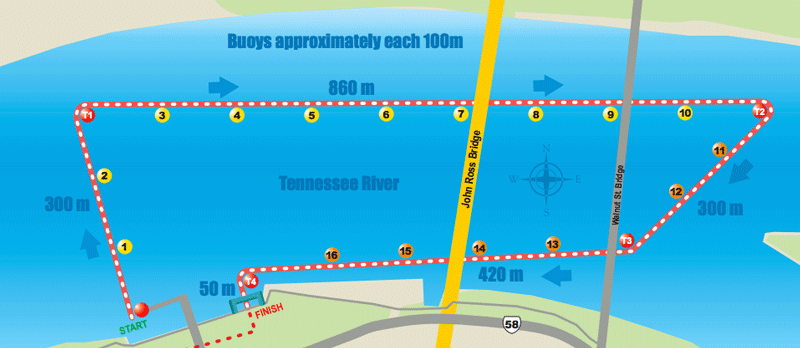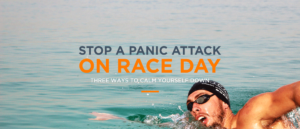The quickest path between two points is a straight line.
If you are swimming off course and swimming further than you need to, you’re going to add seconds (or even minutes!) to your time. Doesn’t matter much how fast you are, if you swim further than you need to you will finish with a slower time!
It’s not always the fastest swimmer that finishes first but the swimmer who stays on line!
Swimming a straight line is the easiest way to improve your swim time on race day. Covering the shortest distance around a course and you’ll finish faster. You’ll come out the water further up in the pack. And overall you’ll have spent less energy than if you add unnecessary meters! That means more energy for the bike and run and a faster overall finish time! Winning!
5 Ways Make Sure You Stay The Course and Swim the Shortest Distance
1. Know the Swim Course

It’s surprising how many triathletes make this mistake! Don’t wait for the briefing on race morning to learn where you should be swimming! You’re smarter than that!
Is the course a square or rectangle?
Do you stick to the right side of the bouys or will you be keeping them on your left?
Is it one lap or two?
The race pack for 99.9% of races answer all these questions and more! Open it, read it, familiarize yourself with the course BEFORE race morning. It’ll take you 10 minutes and save you a ton of frustration!
2. Pick Good Sighting Targets
Here’s a secret I’ll let you in on; the marker buoys that line swim courses are pretty terrible objects to sight off of. They are small (even the big ones!) and can be difficult to quickly spot in the fraction of a second your head is lifted for the sighting stroke.
Rather than sight off the marker buoys, pick big targets to sight off. You’re looking for big structures that line up with the marker buoys. Buildings, trees, towers… anything fixed and big enough to stick out over everything.
Before your race, identify what will be the easiest structure to sight off. Familiarize yourself with its shape. Lock that shape into your mind. As you swim the course on race morning all you will need to do recognize the shape you’re swimming towards. It’s much faster to pick up on a general shape than a specific object. Much easier than trying to find an orange marker buoy in the rising sun!
3. Sight More Often

Now you know the swim course and have easily identifiable shapes to sight off. What’s next?
Make sure you sight your target more often.
There is no magic sighting number but my suggestion is to sight every 4-8 strokes. The rougher the conditions or heavier the current the more often you will need to sight. The flatter and calmer the weather the less you will need to sight.
A sighting stroke will momentarily increase your drag but the energy cost is lower than swimming an extra 100+m. So sight more often.
If you don’t spot your target when you lift your head to sight, you need to repeat the sighting stroke. Simply lifting your head does nothing for swimming a straight line! You have to see your target and be able to adjust your course for it to be effective!
On this note… If you are going to sight often you need to practice sighting… often. Work on making your sighting stroke easy and efficient during your pool workouts. Don’t wait until race day to sight every 4-8 strokes. If you do you’re going to find you swim slower and suffer with a sore neck on the bike! Practice, practice, practice.
4. Know If Your Stroke Is Balanced
There is a lot of focus on swimming with a “Balanced Stroke” in the swimming for triathlon community. Many coaches suggest bilateral breathing to help prevent you veering left or right.
In my experience very few swimmers have a perfectly balanced stroke… And bilateral breathing doesn’t do THAT much to solve the issue. Just being aware if you veer in one direction because of an imbalance will help you swim straighter.
During your next pool swim do a couple of 25’s with your eyes closed.
Which lane line do you end up bumping into?
Now you know which way side you will need to compensate for on race day to swim a straighter line.
5. Understand the Currents & Weather Conditions
Currents, waves, tides and weather conditions play a role in your ability to swim straight! Make sure you know what the conditions are like BEFORE you start your race.
You can feel for currents during your warm up. Notice what direction the current is pushing. Figure out how it will affect you at different stages of the swim course. Then make sure you adjust at each of those points on the course.
Another way to help get a feel for the currents is to watch the stronger swimmers in any of the waves starting before you. What lines do they take? Are they being pushed one way or another? Take note of what they do and you should have a better idea of what you’ll need to be doing.
Related Advice & Tips:
I wrote this post as part of a series on swimming well in open water. Read the rest of the posts in the series here:
Part 1: The Six Culprits Of Slow Open Water Times
Part 2: How To Prevent An Open Water Swim Panic Attack Before Race Day
Part 3: How To Stop A Triathlon Swim Panic Attack On Race Day
Part 4: How To Swim Straight In Open Water
Part 5: Wetsuit Tips For Open Water Swimming









3 thoughts on “How To Swim Straight In Open Water”
Pingback: Triathlon Swimming: Wetsuit Tips For Open Water Swimming
Thanks for all these tips,
Lately I have worked on finding those larger objects above the bouys and found I am more relaxed knowing that I can easily see them instead of the bouy. I also try to find a steady rhythm of 3 breaths on the right side, a bilateral breath where I sight, then 3 breaths to the left, then bilateral breath/sight. Once I feel balanced, I may extend the single-side breathing, but then need to remember not to get in lala land and too much time goes by and I am taking an unexpected turn!.
Thanks for the balance drill, I have been adding it at the beginning and end of every swim session.
My pleasure, Jason.
Sounds like you’ve found a really good balance of breathing to both sides while maximizing the number of breaths you take each minute. A few strokes breathing to the right, followed by 3 strokes to switch you as you sight then breathing every 2 again on the other side is really effective at balancing the breathing and the straight line swim! Good stuff.